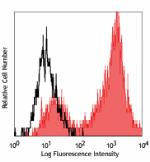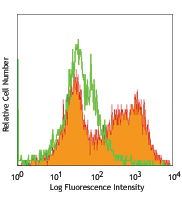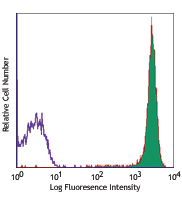- Clone
- MHD1-314 (See other available formats)
- Regulatory Status
- RUO
- Other Names
- DLL1, Delta1, DL1, Delta, delta-like 1, DLL
- Isotype
- Mouse IgG1, κ
- Ave. Rating
- Submit a Review
- Product Citations
- publications

-

Human DLL1 transfected CHO cells stained with MHD1-314 PE
| Cat # | Size | Price | Quantity Check Availability | Save | ||
|---|---|---|---|---|---|---|
| 346403 | 25 tests | 117€ | ||||
| 346404 | 100 tests | 273€ | ||||
Delta-like protein 1 is a type I transmembrane protein. The mature form consist of an extracellular domain of 528 amino acids (aa) that contain a DSL domain and eight tandem EGF repeats; the transmembrane region is 23 aa long and has a 155 aa cytoplasmic domain. After the binding of Notch receptors, the extracellular and cytoplasmic domains are cleaved, and the later is translocated into the cell nucleus to regulate gene expression. Delta-like protein 1 is expressed in heart and pancreas and in a lower amount in brain and muscle. During fetal life, it is transiently expressed during gastrulation and early organogenesis and its expression remains through adult life in hematopoietic tissues and the cortico-medullary region of the thymus.
Product DetailsProduct Details
- Verified Reactivity
- Human
- Antibody Type
- Monoclonal
- Host Species
- Mouse
- Immunogen
- hu DLL1-hu IgG Fc fusion protein
- Formulation
- Phosphate-buffered solution, pH 7.2, containing 0.09% sodium azide and BSA (origin USA)
- Preparation
- The antibody was purified by affinity chromatography, and conjugated with PE under optimal conditions.
- Concentration
- Lot-specific (to obtain lot-specific concentration and expiration, please enter the lot number in our Certificate of Analysis online tool.)
- Storage & Handling
- The antibody solution should be stored undiluted between 2°C and 8°C, and protected from prolonged exposure to light. Do not freeze.
- Application
-
FC - Quality tested
- Recommended Usage
-
Each lot of this antibody is quality control tested by immunofluorescent staining with flow cytometric analysis. For flow cytometric staining, the suggested use of this reagent is 5 µl per million cells in 100 µl staining volume or 5 µl per 100 µl of whole blood.
- Excitation Laser
-
Blue Laser (488 nm)
Green Laser (532 nm)/Yellow-Green Laser (561 nm)
-
Application References
(PubMed link indicates BioLegend citation) -
- Kim H, et al. 2015. Cytotherapy. 17:579. PubMed
- RRID
-
AB_2277361 (BioLegend Cat. No. 346403)
AB_2092809 (BioLegend Cat. No. 346404)
Antigen Details
- Structure
- Type I transmembrane protein, the mature form consist of a 528 aa extracellular domain which contains a DSL domain and eight tandem EGF repeats, a 23 aa transmembranal region and a 155 aa cytoplasmic domain. After Notch binding, a consecutive cleavage of
- Distribution
- Expressed in heart and pancreas, with lower expression in brain and muscle. Is expressed in the cortico-medullary region of the thymus and in the fetal and adult human hematopoietic tissues. In addition, is expressed transiently during gastrulation and early organogenesis in the fetus.
- Function
- Regulates the differentiation and survival of a variety of cell types including B, T and dendritic cells, conditional deletion of Dll1 postnatally completely abrogates MZ B-cell development
- Ligand/Receptor
- Notch receptors
- Cell Type
- Dendritic cells, Tregs
- Biology Area
- Angiogenesis, Apoptosis/Tumor Suppressors/Cell Death, Cell Biology, Immunology
- Molecular Family
- Adhesion Molecules
- Antigen References
-
1. Fu L, et al. 2009. Anticancer Res. 29:3967
2. Zhou J, et al. 2009. Immunity 30:845
3. Radke AL, et al. 2009. Blood 113:3092
4. Six EM, et al. 2004. J. Biol. Chem. 279:55818
5. Hozumi K, et al. 2004. Nat Immunol. 2004 5:638 - Gene ID
- 28514 View all products for this Gene ID
- UniProt
- View information about DLL1 on UniProt.org
Related Pages & Pathways
Pages
Related FAQs
- What type of PE do you use in your conjugates?
- We use R-PE in our conjugates.
Other Formats
View All DLL1 Reagents Request Custom Conjugation| Description | Clone | Applications |
|---|---|---|
| Purified anti-human Delta-like protein 1 (DLL1) | MHD1-314 | FC |
| PE anti-human Delta-like protein 1 (DLL1) | MHD1-314 | FC |
Customers Also Purchased
Compare Data Across All Formats
This data display is provided for general comparisons between formats.
Your actual data may vary due to variations in samples, target cells, instruments and their settings, staining conditions, and other factors.
If you need assistance with selecting the best format contact our expert technical support team.
-
Purified anti-human Delta-like protein 1 (DLL1)

Human DLL1 transfected CHO cells stained with MHD1-314 PE -
PE anti-human Delta-like protein 1 (DLL1)

Human DLL1 transfected CHO cells stained with MHD1-314 PE
 Login / Register
Login / Register 
















Follow Us